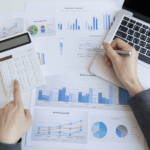Artificial intelligence (AI) has emerged as a major economic force in the United States, compelling a reevaluation of traditional economic drivers. Recently, the financial dynamics have shifted, with AI spending contributing significantly to GDP growth and surpassing traditional consumer-driven metrics. As businesses increasingly integrate AI into their operations, the landscape of economic contribution is experiencing a notable shift, emphasizing technology-driven growth.
In recent years, AI-related expenditures, particularly in data centers, have grown rapidly, outpacing even the telecom boom of the early 2000s. Current figures indicate that AI capital expenditures now contribute approximately 1% to GDP growth, compared to consumer spending, which traditionally has been a substantial driver at various points. AI’s economic impact has exceeded expectations; however, it remains less in magnitude compared to past infrastructural booms like the railroad expansion, which saw a much more significant economic impact.
Is AI Redefining Economic Contribution?
AI investments in the form of data centers now account for a higher share of GDP growth than consumer expenditures. Consumer spending, which has historically accounted for up to 2% of GDP growth, now faces competition from AI, which represents a significant yet different kind of economic stimulus. The insights from financial analysts reflect a changing narrative, with AI shifting from a support role to a leading economic contributor.
Could AI Outperform Railroads in Economic Impact?
AI-related spending has surpassed some historical trends but still falls short of the economic activity seen during the railroad expansion that achieved approximately 6% of GDP contribution. This shift indicates the growing influence of technology on economic dynamics, yet the potential for AI to reach or exceed these historical highs remains to be seen. The scale of growth suggests that while AI is a growing force, its contribution is still evolving.
According to a recent analysis, AI capital expenditure may account for a larger GDP share than most technologies since the railroad era. One analysis suggests,
“AI capex might account for a larger share of GDP than basically any technology since the railroad,”
affirming AI’s dominant position. Another insight highlights,
“AI capex… has added more to GDP growth than consumers’ spending,”
further underscoring the economic potential of AI investments.
In economic reporting and earnings seasons, AI’s growing economic contribution also reflected an ability to influence various sectors. It has contributed to a 3% GDP growth in recent quarters as international trade factors also play a role in these economic dynamics. AI spending growth has proven resilient amidst fluctuating economic conditions, showing its stability and growth potential.
A review of past AI spending trends reveals a gradual but steady increase in its contribution to GDP. Earlier caution surrounding AI’s potential for economic impact is giving way to acknowledgment of its considerable influence, which some industry professionals anticipated might happen sooner. This reflects an economic transformation driven by innovation and AI advancements.
The burgeoning role of AI in the economy signifies an era where technological investments are crucial drivers of growth, marking a shift from traditional economic models centered around consumer spending. Businesses must consider the implications of AI technologies as they continue to shape economic landscapes. Understanding AI’s impact is essential for navigating a future where technology and economic growth are intertwined.










